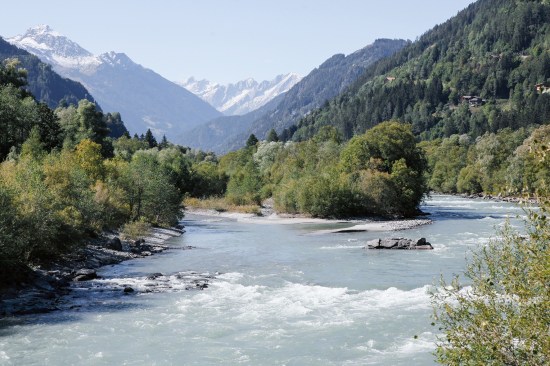Major new book surveys nature and culture along Alpine rivers

The vast Alps mountain range is sometimes described as the ‘water tower’ of Europe. This is because a significant proportion (some estimates say 40%) of the continent’s freshwaters originate from its slopes, supplying drinking water to millions of people.
A newly published book provides a comprehensive survey of the diversity, value and uniqueness of Alpine rivers, and the issues relating to their management and future. ‘Rivers of the Alps: Diversity in Nature and Culture’ is the result of a major collaborative effort involving 150 experts from six Alpine countries, led by editors Susanna Muhar, Andreas Muhar, Dominik Siegrist and Gregory Egger.
Over 34 thematic chapters, richly illustrated with images and maps, the book offers a history of Alpine rivers and their geomorphology, which has shaped a range of unique habitats for wildlife. The book then explores how people have settled and used Alpine river landscape over time, covering wide-ranging topics of flood protection, hydropower and transport alongside mythology, tourism and art. The challenges for environmental management that arise from the dynamic human-nature interactions in Alpine river catchments are then considered. Finally, portraits of the individual characteristics of 54 Alpine rivers are offered. Susanna Muhar says: “we as editors aim to contribute to a greater awareness regarding the unique nature and value of Alpine rivers as well as the ways in which they are endangered.”

Alpine rivers: woven threads of nature and culture
The book is timely and important: Alpine landscapes are shaped by their rivers and streams, both physically and culturally, but their complex systems are vulnerable to environmental change. A number of large European rivers – including the Rhine, Rhône, Inn and Po – have headwaters in the Alps, carrying water across the continent to the North, Mediterranean, Adriatic and Black Seas. Alpine river valleys have long been locations of human settlement, with their waters used for drinking, washing and irrigation. In recent centuries, tourists have increasingly explored Alpine valleys, taking advantage of their clear waters for boating, fishing and swimming. Alpine rivers support a unique range of biodiversity. They provide habitat for a number of species, including fish, invertebrates, amphibians, reptiles, mammals and birds.
Dominik Siegrist says: “The Alps are in many ways connected to their rivers. The alpine spaces are formed by the rivers, and the streams and large rivers characterise the Alpine landscapes. In the mountains and valleys, fluvial landscapes are an element of beauty but also the cause of the destruction of infrastructures and settlements. They are a source of drinking water for entire countries. Rivers also donate energy in different ways – for those seeking relaxation as well as for running the turbines of hydropower plants.”
Andreas Muhar continues: “The rivers of the Alps play an important role for the rest of Europe: they provide water and hydropower way beyond the limits of the Alps. The development of human settlements and infrastructure widely followed the course of the rivers. Their valleys form important corridors for transport on the rivers themselves and on roads alongside them. Today’s multi-functional river landscapes require that we find the right balance between utilisation and conservation, as well as integrate demands from many different fields such as energy production, material extraction, flood protection, agriculture, settlement, industry and recreation.”

Multiple pressures on Alpine rivers
However, despite their importance, Alpine rivers are increasingly threatened by human activity. The effects of climate change are being strongly felt in the Alps. In the book’s introduction, Klement Tockner states that air temperatures in the Alps have risen by just under 2°C over the past 100 years – almost twice the global average. Climate warming is changing the pattern and extent of glacier melt in the Alps. In 1876, glaciers covered an area of 1,800km² in the Alps. Climate change has caused the glaciated area to shrink by 40% in Austria and 30% in Switzerland since then, Tockner outlines.
This is important because glacial melt is a key element of the Alpine water cycle. Changing melting patterns alter the amount and timing of river flows downstream, and with it the aquatic ecologies and human livelihoods that rely on them. Climate change models project ongoing increases in air temperature through the 21st Century, with a potential complete loss of Alpine glaciers by the end of the century. This could mean more droughts and low river flows in summer, and more winter flooding and landslides in river valleys in the future.
Alpine river flows are also increasingly altered by hydropower projects. Only a small number of Alpine rivers remain in a ‘near-natural’ free-flowing state because of a recent boom in small hydropower plant construction. The seeming ‘eco-friendly’ credentials of such low-carbon energy production schemes are potentially compromised by the negative effects hydropower can have on the health of the wider river ecosystem.

A collaborative resource to support environmental policy and management
These key issues, and how they might be managed and mitigated through environmental management and policy (such as the Alpine Convention), are central concerns of the book. Editor Gregory Egger explains: “Our book gives the first Alpine-wide overview of all essential topics in the context of rivers and river landscapes. Particular attention is paid to the presentation of the characteristics of Alpine rivers. The book is intended to address both experts and readers interested in nature.”
Susanna Muhar says: “We are facing global changes regarding climate, land use, food and energy production, urban agglomerations and many other challenges. Freshwater ecosystems, and the functions and services they provide, are increasingly affected by these changes. In light of such adversities, it is particularly crucial to preserve those rivers and floodplain corridors that are still dynamic and interconnected. Such systems buffer flood events, provide habitats for reproduction and refugia from disturbances and enable species movements to suitable habitats in other parts of the watershed, particularly in response to transforming environmental conditions such as rising temperatures or changing hydrological regimes.”

‘Rivers of the Alps: Diversity in Nature and Culture’ is the result of extensive interdisciplinary collaboration.
Project manager Kerstin Böck says: “The book is the result of a major geographic project and includes contributions of more than 150 experts from all over the Alpine space. Coordinating this large number of people was sometimes challenging and required patience and a bit of tenacity.
“Over 10,000 mails were exchanged from the start of the project until now, and it took a lot of discussions until the present concept was ready. However, the result speaks for itself and brings together expert knowledge on all the important issues relating to Alpine rivers.”
+++















Comments are closed.